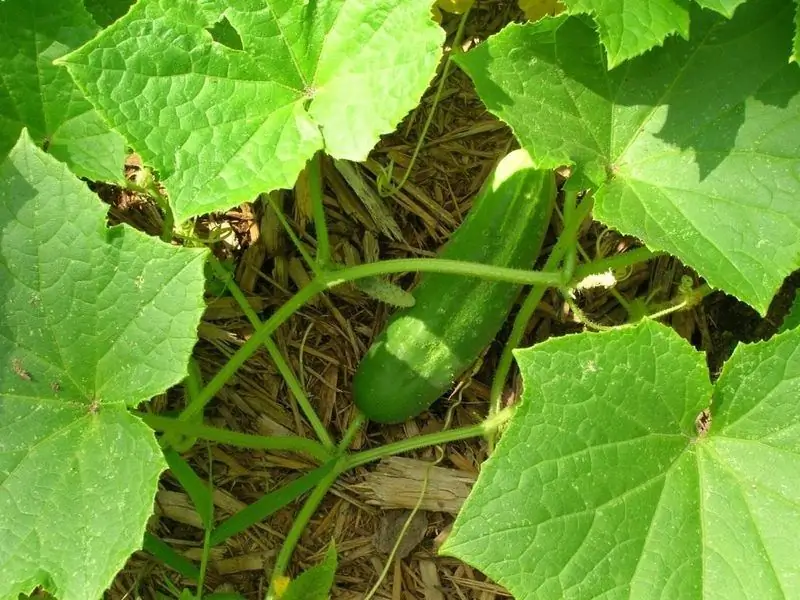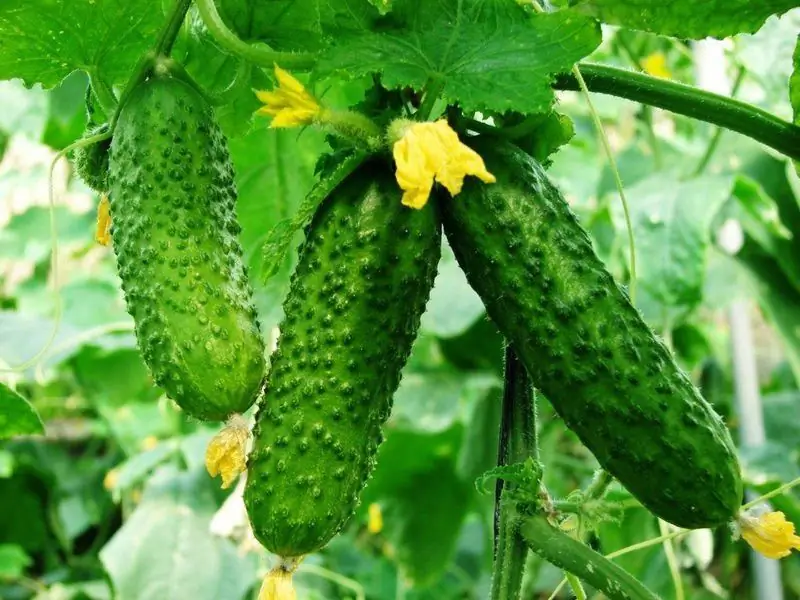
Table of contents:
- Author Bailey Albertson [email protected].
- Public 2023-12-17 12:53.
- Last modified 2025-06-01 07:32.
Simple but effective top dressing for a rich harvest of cucumbers in the open field

Cucumbers are distinguished by active growth and abundant fruiting, while their roots are located in the upper layer of the soil, and only from there they take food. Therefore, the root zone is quickly depleted. For good yields, you need to regularly feed cucumbers, and for each stage of development, fertilizers are different.
What fertilizers do cucumbers need in the open field
For proper development, cucumbers need macronutrients: phosphorus, potassium, nitrogen, as well as trace elements, especially calcium and magnesium. If you plant cucumbers with seedlings, then the first feeding should be phosphorus, since it is phosphorus that stimulates root formation. With its help, the bushes will quickly take root in a new place and grow. Cucumbers, sown directly into the ground, are fed for the first time when a real cucumber grows between the cotyledon leaves. During this period, nitrogen fertilization is necessary.

Cucumbers planted with seedlings are fed for the first time with phosphorus fertilizer, and those sown in a garden with nitrogen
The second and subsequent dressings are done at intervals of 7-10 days throughout the growing season:
- Before flowering, you need to apply fertilizer containing equal proportions of phosphorus, potassium, nitrogen.
- At the beginning of flowering and before mass fruiting, fertilizing with a predominance of potassium is needed.
- During fruiting, fertilize again with complex mixtures with nitrogen, phosphorus and potassium in the composition.
At any time, it is desirable that the dressings contain microelements: sulfur, copper, manganese, calcium, magnesium, etc.
Mineral fertilizers for feeding cucumbers
Any successful farmer will tell you that you cannot grow a good harvest without mineral fertilizers. And so that "chemistry" does not cause harm to health, you need to comply with the terms and dosages:
-
Phosphorus-containing fertilizers (applied after transplanting):
- superphosphate (20-26% phosphorus) - 30 g / m² of the garden;
- double superphosphate (42-50% phosphorus) - 15 g / m²;
- potassium monophosphate (50% phosphorus, 34% potassium) - 10-15 g / m² or dissolve this amount in 10 liters of water and water 1 m² of land under cucumbers;
- diammonium phosphate (46-52% phosphorus and 18-23% nitrogen) - scatter a teaspoon around each bush and mix with the top layer of soil.
-
Nitrogen is needed at the very beginning of the growing season:
- ammonium nitrate (33-36% nitrogen) - 5-10 g / m² or dissolve in 10 liters of water and pour over 1 m²;
- carbamide or urea (46% nitrogen) - 5-10 g / m².
-
Potash fertilizer for fertilizing during the flowering period:
- potassium sulfate (48-52% potassium oxide) - dissolve 25 g in 10 liters of water, consumption - 2.5 l / m²;
- potassium magnesium (from 35% potassium oxide and from 8% magnesium) - 15-20 g / m².
-
Complex fertilizer for fertilizing before flowering and during fruiting:
- nitroammofosk (nitrogen, phosphorus and potassium 16% each) - 15-20 g / m²;
- all kinds of modern mixtures and concentrates for vegetables (Florizel, Fertika, Agricola, Bogatyr, etc.), which contain nitrogen, phosphorus and potassium in equal proportions.
Video: how to feed cucumbers
Almost all store-bought complex mixtures contain trace elements. By using them, you will save yourself the need to buy a bunch of fertilizers containing, for example, only magnesium, manganese or boron. Nowadays, gardeners pay a lot of attention to calcium, without which the plant does not absorb a single nutrient. To add it, use calcium nitrate - 20-30 g / m², apply top dressing three times per season:
- when bushes of 3-4 leaves are formed:
- at the beginning of fruiting;
- after 3-4 collections of Zelentov.
If the mineral fertilizer dissolves easily in water, then you can add it in the form of a solution. For example, the dosage of urea is 5-10 g / m², dissolve in 10 liters of water and spread over 1 m². But usually granules or powders are scattered on wet ground and embedded in the top layer by loosening.
Natural fertilizers
Organic fertilizers (mullein, bird droppings, nettle infusion) and wood ash are intended only for amateur cultivation of cucumbers, since they do not have an exact formula. Nobody knows how many grams or percent each nutrient will contain in the feed. There are only generally accepted concepts that organic matter contains more nitrogen, while ash, on the contrary, lacks it, but phosphorus and potassium prevail, and in addition, it contains about 40 trace elements.
Recipe for organic nitrogen fertilizing:
- Fill the container by 1/3 with mullein or fresh bird droppings, and if you are making an infusion of nettle or herbs - by 2/3.
- Fill the container with warm rainwater, but not to the brim, leave room for foaming.
- Ferment under a loose lid for 5-7 days, stirring 1-2 times a day.
- Feed by diluting with water: infusion of nettle or any herb in a ratio of 1 to 5-7, mullein - 1 to 10, and poultry droppings - 1 to 20. Spend 10 liters on a garden of 2-3 m².
The recipe for a phosphorus-potassium supplement with trace elements is quite simple. Pour a glass of ash into a bucket of water, loosen it and pour immediately until the suspensions have settled. Use the solution as you would for regular watering. For good growth of cucumbers, it is recommended to alternate ash dressings with nitrogen ones from organic matter with an interval of 7-10 days.

If the garden is damp from the rains, you can simply powder the earth with ashes and loosen
Folk recipes
Gardeners love to feed cucumbers with various improvised means, the most popular of which are yeast and onion peels. Yeast is good because it stimulates the growth of roots, in the process of their vital activity phosphorus and nitrogen enter the soil, but potassium and calcium are consumed. And also these fungi actively process organic matter. Therefore, yeast top dressing is applied only to the soil well filled with humus or compost. And in order to replenish the spent reserves of potassium and calcium, 5-7 days after yeast, make an ash top dressing.
How to feed cucumbers with yeast:
- In a glass of warm water, dissolve 10 g of dry yeast and 2 tbsp. l. Sahara.
- When the liquid foams, pour it into a bucket of water.
- Stir and water over a 2-3 m² garden bed.

For active growth, cucumbers are fed with yeast
Yeast "works" only in warm soil (about +20 ° C). They can be fertilized no more than 2-3 times per season: at the beginning of growth, during abundant flowering and fruiting. As for the onion husk, it is rich in vitamins, phytoncides, potassium, phosphorus, calcium, and iron salts. Its infusion is not only a top dressing, but also a growth stimulant, helps to cope with fungal diseases and to endure unfavorable weather conditions.
Onion dressing for cucumbers:
- Pour the husk in a volume of 1 liter into a saucepan.
- Pour 1 liter of water, bring to a boil.
- Simmer for 5 minutes to kill mold and other fungi and pest larvae that may be on the husk.
- Strain and bring to 10 liters with cold water.
- For feeding on a 10-liter watering can, take 2 liters of solution. Use as for normal watering with clean water.
Cucumbers are watered with decoction of onion husks 3-4 times per season, it is possible over the leaves.
For an excellent harvest, cucumbers need nitrogen, phosphorus, potassium and trace elements. Their exact dosage, which means that the best possible results can be achieved using mineral fertilizers. On amateur sites, opponents of "chemistry" often use mullein, dung, wood ash, infusion of nettle and onion husks.
Recommended:
Growing Cucumbers On A Trellis In The Open Field - Rules + Photos And Videos

Features of growing cucumbers on a trellis in the open field. Construction and installation of trellises, preparation for planting cucumbers, rules for planting in open ground
How To Feed Cucumbers In The Open Field If The Leaves Turn Yellow And In Other Cases

Top dressing with slow growth of cucumbers. How to fertilize if the leaves turn yellow. How to feed in a polycarbonate greenhouse. Feeding with yeast. Instructions. Video
How To Plant And Grow Cucumbers In The Open Field: Plant Seeds, Properly Care For Plants (water, Form, Tie Up)

What varieties and hybrids of cucumbers can be grown in the open field. Features of planting seeds and seedlings. Choice of place and timing. The nuances of care and formation
How To Tie Up Cucumbers In The Greenhouse And Open Field

What are the benefits of a garter of cucumbers, what problems it relieves. Universal rules. Habitual and non-standard ways of tying + photos, videos
Corn Pickled Like Cucumbers: Original Harvest With Excellent Taste

How to pickle corn like cucumbers. Delicious corn rolling recipes
